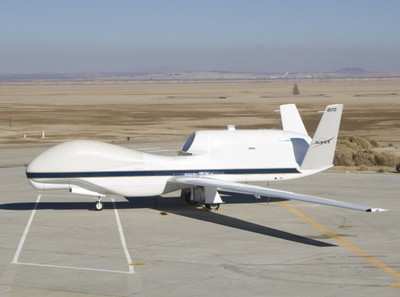Tue, Jan 29, 2013
HALE Unmanned Aircraft To Collect Data On Earth's Humidity, Atmospheric Composition
A NASA Global Hawk is currently conducting science missions to study the impact of atmospheric change on the Earth's climate. The Global Hawk is collecting data and helping scientists learn more about the humidity and chemical composition of air entering the tropical tropopause layer of the atmosphere and its impact on the Earth's overall climate.

The Airborne Tropical TRopopause Experiment (ATTREX) campaign, sponsored by NASA, began on Jan. 16 at NASA's Dryden Flight Research Center at Edwards Air Force Base, CA, and will conclude on March 15. In collaboration with NASA, Northrop Grumman is also providing engineering analysis, mission planning, maintenance, pilots, and flight operations support for these important science missions.
"Global Hawk is able to fly as high as 65,000 feet for periods up to 31 hours, providing the unique combination of high altitude and long endurance performance capabilities that allow the science community to study and deepen our understanding of climate change," said Fred Ricker, vice president and deputy general manager for Advanced Development Programs for Northrop Grumman's Aerospace Systems sector. "Global Hawk is the only aircraft able to repeatedly access the atmosphere above and below the tropopause layer, and it can do that over thousands of miles."
NASA's ATTREX multiyear campaign is studying the region of the upper atmosphere where pollutants and other gases enter the stratosphere and potentially influence climate. Studies have shown that even small changes in stratospheric humidity may cause climate impact that is more significant than the impact of greenhouse gases.
Over the past few years, the NASA Global Hawk program has supported numerous science research campaigns, including:
- Fall 2012: Supported environmental scientists during Hurricane and Severe Storm Sentinel (HS3) missions. The HS3 missions studied the processes of hurricane formation and intensity change in the Atlantic Ocean. HS3 operations and flights were executed out of Wallops Island, Va. This was the first joint NASA-Northrop Grumman deployment from the Dryden Flight Research Center.
- Spring 2011: Flew winter storm missions over the Pacific and Arctic, observing, among other weather phenomena, an "atmospheric river," which sometimes causes flooding on the West Coast.
- Fall 2011: Supported ATTREX missions over the Pacific by climbing and descending between 45,000 feet and 65,000 feet, gathering information on climate change due to water vapor and other aerosols.
- September 2010: Supported the Genesis and Rapid Intensification Processes hurricane surveillance missions that provided extended monitoring of changes in hurricane intensity during five different storms in the southern Caribbean and western Atlantic.
- April 2010: Completed the first science research campaign called GloPac, studying the atmosphere over the Pacific Ocean and Arctic.
(NASA Global Hawk image from file)
More News
Aero Linx: Florida Antique Biplane Association "Biplanes.....outrageous fun since 1903." That quote really defines what the Florida Antique Biplane Association (FABA) is all about.>[...]
Beyond Visual Line Of Sight (BVLOS) The operation of a UAS beyond the visual capability of the flight crew members (i.e., remote pilot in command [RPIC], the person manipulating th>[...]
Also: ForeFlight Upgrades, Cicare USA, Vittorazi Engines, EarthX We have a number of late-breaking news highlights from the 2024 Innovation Preview... which was PACKED with real ne>[...]
“For Montaer Aircraft it is a very prudent move to incorporate such reliable institution as Ocala Aviation, with the background of decades in training experience and aviation>[...]
Maximum Authorized Altitude A published altitude representing the maximum usable altitude or flight level for an airspace structure or route segment. It is the highest altitude on >[...]
 ANN's Daily Aero-Linx (04.13.24)
ANN's Daily Aero-Linx (04.13.24) ANN's Daily Aero-Term (04.13.24): Beyond Visual Line Of Sight (BVLOS)
ANN's Daily Aero-Term (04.13.24): Beyond Visual Line Of Sight (BVLOS) Airborne 04.09.24: SnF24!, Piper-DeltaHawk!, Fisher Update, Junkers
Airborne 04.09.24: SnF24!, Piper-DeltaHawk!, Fisher Update, Junkers Aero-News: Quote of the Day (04.14.24)
Aero-News: Quote of the Day (04.14.24) ANN's Daily Aero-Term (04.14.24): Maximum Authorized Altitude
ANN's Daily Aero-Term (04.14.24): Maximum Authorized Altitude



